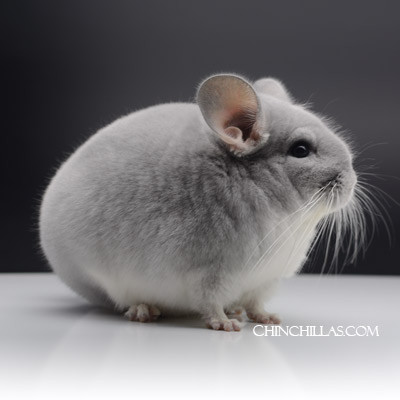Chinchilla Breeds

(pictured l-r) Ebony & White Mosaic Locken, Tan Royal Persian Angora, and (below) powder Blue Diamond chinchillas
A 'breed' consists of a closed gene pool, or breeding population, within a species of animals. Individuals within this group are expected to exhibit defined characteristics of type. A breed is uniform and is expected to ‘breed true.’ Homozygosity, in turn, increases the odds of producing true type. An upside to quality purebred animals is their ability to produce consistent progeny that meet certain expectations in terms of performance, structure, or aesthetics. The downside of a purebred animal is the closed gene pool, by which genetic variance inevitably diminishes over time.
A good example of a breed is the purebred or Asil Arabian horse. The Arabian horse is the oldest pure breed in the world. There is even some debate as to whether this ancient oriental breed, geographically isolated for millenia, remains its own original species - Equus agilis. These horses cannot be crossed with any non-purebred Arabian horses and ever produce purebred offspring.  If a purebred Arabian were outcrossed, and the offspring bred back to purebred Arabians for ten generations, resulting in a foal with 99.95% Arabian blood, that foal would be a grade horse, not an Arabian. Even after 100 generations of breeding the offspring back to purebred Arabians, only grade horses would be produced, but no purebreds. The breeding population is closed.
If a purebred Arabian were outcrossed, and the offspring bred back to purebred Arabians for ten generations, resulting in a foal with 99.95% Arabian blood, that foal would be a grade horse, not an Arabian. Even after 100 generations of breeding the offspring back to purebred Arabians, only grade horses would be produced, but no purebreds. The breeding population is closed.
There are different colors, fur types, and species - Chinchilla lanigera and Chinchilla chinchilla - of chinchillas, but no true ‘breeds.’ This may be a good thing, for the time being at least. The genetic diversity of the domestic chinchilla is already limited by the relatively small number of original imports from the wild. This low variance would be further reduced if breeding populations were restricted to closed breeds. Further, the loss of any mtDNA, being the determinant of dam lines and strain influence, would be a net loss for domestic chinchillas.
A sufficiently diversified gene pool should be protected in any breeding population. Genetic variation is important, being the basis for a strong immune system, the ability to adapt to changing environments, and hybrid vigor.
Visit Chinchilla Photos to see pictures of the different chinchilla color and fur mutations.